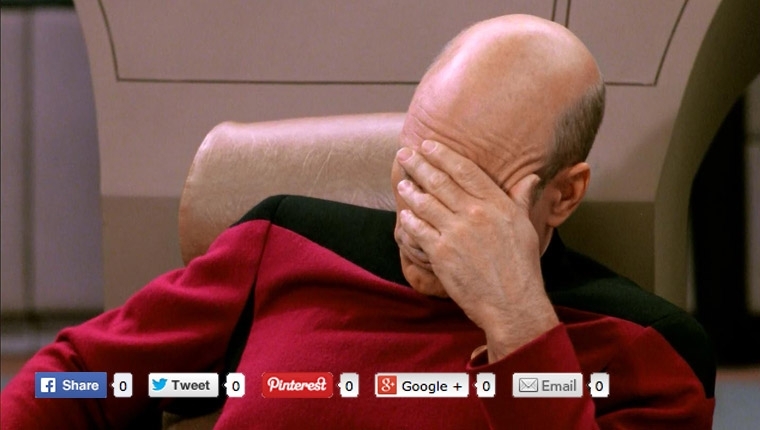


16-07-2014

Proponents of Social Media sharing widgets will no doubt disagree with the majority of what I'm about to say, but at Code 7 we are firmly opposed to using them on any new websites being developed by our team.
Content Sharing
Advocates will say that sharing widgets allow your users the ability to share your content with ease and that they are providing your current audience with a means to provide word-of-mouth advertising to their friends, who will hopefully become your future audience.
Not that sharing your content shouldn't be important to you. Sharing is a vital part of how many organisations build their online presence, but widgets may not be the best delivery method.
Government Statistics
The Gov.uk website added sharing widgets to its website in the latter part of 2013 and some analysis delivered via their blog in February, after a 10 week test period, makes for some interesting reading.
Some may argue that content via the Government's website might not be the sort of information you might typically share on Facebook or Twitter but according to the numbers these widgets lead to an overall sharing rate of just 0.2%. That's 14,000 shares from 6.8 million page views.
It's necessary to point out here that these figures are only based upon sharing via the sharing widgets and doesn't include content shared via other means, through mobile phone in-built technology or simply copying and pasting URLs.
In fact, In the follow up comments below the article the author writes that in desktop usability testing most people did, in fact, tend to copy and paste rather than using the widgets.
Some may argue that, in fact, a 0.2% sharing rate isn't actually that bad. Hopefully, by the time you've read this piece I'll have changed your mind in that respect. It's about balance. Sharing, good. Sharing widgets, bad.
Analytics and Calls to Action
Some recent analysis by Visual Website Optimizer even goes so far as to definitively state that, far from adding kudos and increased traffic to your site the reverse might actually be true.
Their findings were based upon Taloon.com, a Finland based e-commerce hardware store which removed their social sharing widgets in order to A/B test whether their presence had a negative effect on the main call to action; which in this instance was adding a product to an online shopping basket.
According to the numbers they saw an 11.9% increase in CTA clicks having removed the social media widgets. That was based on 10,000 page visits.
Again, I find these kind of analytics pretty fascinating. According to this particular study the assumption for this level of increased activity is twofold.
The negative impact of having a very low number, in some cases zero, social shares was one of these. The second being the distraction of having these sharing widgets on the same page as the main CTA. I'll come back to both of these points in a moment.
Reasons to Avoid Widgets
The reason why we, at Code 7, are giving social sharing widgets the thumbs down is many fold.
Branding Problems
Why are you looking to add them exactly? What purpose do they serve? In many instances we'll help a new client with branding and if we haven't been asked it's because they've undoubtedly spent a fair chunk of money making sure they're got it right already. Why then would you want to add widgets to your site that don't fit with your logo, colour schemes and visual elements? We're enthusiastic minimalists and believe less is often more. Don't clutter your site with unattractive icons which don't tie into your overall look.
Page Loading Speeds
One of our other major bugbears is the effect social media widgets have on page loading speeds, particularly on mobile devices where bandwidth and latency are at a premium. They may not look like it but those little widgets are actually fairly sizeable chunks of data and the negative impact on page loading is considerable, even though these days most are asynchronous. Some anecdotal evidence from testing we've carried out suggests page loading speed can be increased by over a second. In today's fast paced world, that's not inconsiderable. There are workarounds but I'll get back to my original point; why bother when they add no value to your website. Google has been using site speed as a ranking element for over 4 years, so ironically for SEO purposes maybe its time to remove or not use them in the first place.
Negative Impact of Low Shares
Touching back upon Taloon.com's analysis of their e-commerce website I also think it's important to consider the negative impact of a low number, or even zero, social shares. If you're not particularly well known or followed, those social sharing widgets can make you look a little bit desperate. There's nothing more melancholy than a well written article with no shares, and often your readers will be reluctant to share on that basis alone.
Calls to Action
In terms of why you would want to leave these widgets anywhere on your site where they may divert your users from the desired call to action, I'm not sure we really need to expand upon this. It seems pretty obvious to me that by potentially directing your clients away from your site, you are in fact putting distance between your intended purpose and the user.
Conclusion
If you are going to use social media sharing tools, I'd recommend using sharing buttons (static HTML versions rather than iFrames) and only integrating them once the main call to action has been followed through. Never divert away from your main CTA. If people love your content, they'll share it regardless of whether you've got sharing widgets/buttons or not. It's all about quality content.
You can still track how your content is being shared via the various different networks and platforms by the way. There are lots of different free tools out there. You don't have to use social media sharing widgets to do it.
Social Media is not easy, there's no trick to it. Excellent content, hard work and constant human interaction are how you build your online presence.
I'll leave you with one final thought from Matt Linderman, creator of vooza.com, and previously an employee of Basecamp, who says '......think twice before badgering readers with “vote for me” pleas. The hectoring is tiresome, it results in extraneous visual noise, it makes your site look cheap, and the benefits are dubious at best. Instead, focus on delivering great content. If you do, people will figure out how to spread the word just fine.'
Wise words my friends.





